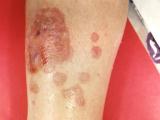Implementation of a national safety program that helps US hospitals to establish antibiotic stewardship programs (ASPs) and clinicians to improve their antibiotic decision-making was associated with reduced antibiotic use and fewer hospital-onset Clostridioides difficile infections, according to a study today in JAMA Network Open.
The study, conducted by researchers with the Johns Hopkins University School of Medicine, the University of Chicago, and the Agency for Healthcare Research and Quality (AHRQ), evaluated the impact of AHRQ's Safety Program for Antibiotic Use, which was established in 2017 to support hospitals in their efforts to establish ASPs and successfully implement stewardship principles. ASPs have been associated with reduced antibiotic use in individual hospitals across the country.
Tools to 'self-steward'
As of Mar 2020, US hospitals are now required to have ASPs in order to be reimbursed by the Centers for Medicare and Medicaid Services. But maintaining ASPs requires resources that not all hospitals have, particularly smaller, rural hospitals that lack access to infectious diseases specialists. Also, stewardship programs in general have been more focused on establishing institutional guidelines than on teaching clinicians to "self-steward" their antibiotic use.
That's where the AHRQ Safety Program comes in. In addition to helping hospitals build sustainable ASPs, the program helps frontline clinicians incorporate stewardship principles into routine decisions about antibiotics.
Among the components of the program are webinars on diagnosing and managing infectious diseases for which antibiotics are frequently prescribed and on the science of antibiotic safety, team antibiotic review forms that facilitate discussions among stewardship teams about appropriate prescribing, antibiotic time-out tools, and posters displaying commitments to judicious antibiotic use.
"Giving clinicians tools to prescribe antibiotics appropriately can make care safer by ensuring that patients get the treatment they need while minimizing unintended harm," study co-author Melissa Miller, MD, a critical care physician in AHRQ's Center for Quality Improvement and Patient Safety, said in an AHRQ press release. "Antibiotics can be lifesaving, but they must be used thoughtfully in order to preserve their effectiveness."
Declines in antibiotic use, C diff infections
Over the course of a year, from December 2017 through November 2018, 437 US hospitals enrolled in the AHRQ safety program, and Miller and her colleagues set out to evaluate its impact on overall antibiotic use during that year, measured in days of therapy (DOT) per 1,000 patient-day (PD), and hospital-onset C difficile infections, which can be a reflection of antibiotic overuse.
Of the 437 hospitals that enrolled, 402 remained in the program until the end of the study period. The 402 hospitals included 167 community hospitals (42%), 122 mid-level teaching hospitals (30%), 85 critical access hospitals (21%), and 28 academic medical centers (7%). A total of 173 hospitals (43%) did not have access to infectious disease specialists at the beginning of the program, and 41% had fewer than 100 beds.
Comparing antibiotic use in the beginning of 2018 (January and February) with the end (November and December), the researchers found that antibiotic use declined from 900.7 to 870.4 DOT per 1,000 PD (-30.3 DOTs; 95% confidence interval [CI], -52.6 to -8.0), with fluoroquinolone use declining by 20.4 DOT per 1,000 PD.
The decline was even higher among hospitals units that were more engaged in the safety program. Among 276 units that completed an average of more than 10 team antibiotic review forms a month (compared with 200 units that completed an average of fewer than 10 a month), antibiotic use declined by 34.2 DOT per 1,000 PD.
To determine whether the observed decline in antibiotic use reflected an overall downward trend in US hospital antibiotic use in recent years linked to greater awareness of stewardship and the importance of judicious antibiotic prescribing, the researchers analyzed a cohort of hospitals in the Premier Healthcare Database, which contains drug use information for about a fourth of US hospitals, during the same period.
The decline in antibiotic use among those hospitals was only 9.0 DOT per 1,000 PD—an indication that the AHRQ safety program may have played a role in the observed decline in antibiotic use among the participating hospitals.
The number of hospital-onset C difficile cases, meanwhile, fell from 6.3 per 10,000 PD to 5.0 per 10,000 PD, a decline of 19.5% (95% CI, -33.5% to -2.4%).
The analysis also found that, among participating hospitals, adherence to what the study authors identified as the four key ASP components—active interventions before and after prescription of select antibiotics, availability of local guidelines for infections, dedicated salary support for ASP leaders, and quarterly reporting of antibiotic use—rose from 8% at the beginning of the study to 74% at the end.
"The Safety Program was able to demonstrate that establishing ASPs and training frontline clinicians may improve antibiotic use, even in hospitals without infectious diseases–trained physicians or pharmacists. In fact, we were able to train clinicians—often staff pharmacists—to become stewardship leaders in their facilities," Miller and her colleagues wrote.























